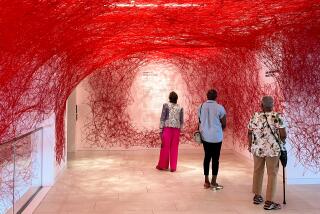Getty Research Institute buys Knoedler gallery archive
When the Soviet government sold hundreds of paintings from the State Hermitage Museum in Leningrad in the 1930s, including masterpieces by Rembrandt, Raphael and Velazquez, they ended up working closely with one American art gallery: Knoedler & Company in New York.
The gallery abruptly closed last year after more than 160 years in business. Now the Getty Research Institute is acquiring for an undisclosed sum the sales books documenting the Hermitage deals, among other resources that make up Knoedler’s vast private archives. The trove of sales books, artists’ letters, telegrams, photographs and rare books will fill up three large shipping containers.
Thomas Gaehtgens, the director of the GRI, says the institute is a natural home for the Knoedler archive because it has been focused “since the beginning on the history of provenance, collecting and the art market. This complements our holdings in a wonderful way.”
He described the material as a boon to scholars studying the rise of the art market. In particular he suggests it will tell a fuller story about the movement of art from Europe to America and into the hands of major collectors such as Andrew Mellon, Henry Clay Frick and Sterling Clark, who went on to form some of America’s leading museums.
During the Hermitage negotiations, for example, Knoedler was instrumental in selling 21 masterpieces to Mellon. Mellon later donated them to the museum he founded, the National Gallery of Art in Washington, D.C. A search for Knoedler as “former owner” on the National Gallery website turns up 519 entries.
“Prices alone, that’s not interesting, or that’s not all that’s interesting,” Gaehtgens said. “This archive can give us the basis for telling the story about how the museums in America have been built or developed.
“How did European art move into the hands of Americans? It might even tell us why American art did not move at the same time to Europe, why the national galleries of other countries do not have great [Thomas] Eakins.”
As for the Getty’s own, still-growing collection, at least a dozen paintings and drawings now at the museum can be traced back to Knoedler at one point or another, including Vincent Van Gogh’s “Irises” and Edouard Manet’s “Portrait of Madame Brunet.” Knoedler sold both of those works to New York collector Joan Whitney Payson decades before they made their way to the Getty.
The Getty has acquired the Knoedler archive, running from around 1850 until 1971, from the gallery’s owner Michael Hammer (who is the grandson of collector Armand Hammer). The material begins shortly after the Paris gallery Goupil opened up a branch in New York, which Michael Knoedler bought out in 1857.
The gallery did not close up shop until 2011, but the 1971 cut-off makes sense for another reason: There are multiple lawsuits pending against the gallery for handling alleged forgeries of Abstract Expressionist paintings in recent decades.
“We didn’t want anything to do with that,” said Gaehtgens. “Our lawyers separated the controversial material -- that’s not our business.”
He expects the less controversial material to arrive at the Getty this year so that they can begin organizing it and making it available to scholars. First up, he promises to digitize the stock books so researchers can find historic sales prices online.
MORE:
CRITIC’S PICKS: Fall Arts Preview
TIMELINE: John Cage’s Los Angeles
More to Read
The biggest entertainment stories
Get our big stories about Hollywood, film, television, music, arts, culture and more right in your inbox as soon as they publish.
You may occasionally receive promotional content from the Los Angeles Times.










